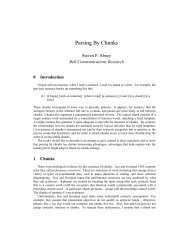The English Noun Phrase in its Sentential Aspect - Vinartus
The English Noun Phrase in its Sentential Aspect - Vinartus
The English Noun Phrase in its Sentential Aspect - Vinartus
Create successful ePaper yourself
Turn your PDF publications into a flip-book with our unique Google optimized e-Paper software.
38 CHAPTER 2. NOUN PHRASE AND SENTENCE3 <strong>The</strong> DP-Analysis3.1 Concepts and Term<strong>in</strong>ologyIhave presented the essence of the position which I will defend <strong>in</strong> the restof this thesis: that the noun phrase is headed by an In-like category <strong>in</strong>many languages, <strong>in</strong>clud<strong>in</strong>g <strong>English</strong>, and probably universally. Iwould liketo spell out my hypothesis carefully here, and dene my term<strong>in</strong>ology.3.1.a\Inectional" ElementsFirst, I have spoken of an \In-like" node, or an \Inectional element" <strong>in</strong>the noun phrase, without den<strong>in</strong>g precisely what I mean. I consider thenode In to be typical of a class of elements, that I have elsewhere calledfunctional elements,<strong>in</strong>contrast with thematic elements. 9 <strong>The</strong>y are typicallycalled \non-lexical categories" I resist this designation because I assumethat complementizers and modals, etc., have lexical entries like any otherword. <strong>The</strong> two uncontroversial functional elements are Complementizerand Inection.<strong>The</strong> primary property of functional elements is this: they select a uniquecomplement, which is not plausibly either an argument or an adjunct ofthe functional element. C selects IP, and I selects VP. CandIdonottake typical arguments (noun phrases, prepositional phrases, subord<strong>in</strong>ateclauses), not even as an option. C and I do not take multiple arguments,but only one IP, oroneVP, respectively. And semantically, at least onan <strong>in</strong>tuitive level, C and I contrast with N, V, A, etc., <strong>in</strong> that they donot describe a dist<strong>in</strong>ct object from that described by their complement.In That John hit the ball, for <strong>in</strong>stance, the VP hit the ball (<strong>in</strong>tuitively)describes an act of hitt<strong>in</strong>g, the IP John hit the ball describes an act ofhitt<strong>in</strong>g, and the CP that John hit the ball also describes an act of hitt<strong>in</strong>g.This <strong>in</strong>tuition is a major motivation for the cont<strong>in</strong>u<strong>in</strong>g debate over whetherV is not actually the head of the sentence. In the \pass<strong>in</strong>g on" of thedescriptive content of their complements, functional heads contrast withthematic heads. <strong>The</strong> noun phrase the ball describes a ball when that nounphrase is the complement ofaverb, as <strong>in</strong> hit the ball, the VP emphaticallydoes not describe a ball, but an action <strong>in</strong> this case, an act of hitt<strong>in</strong>g.We see, then, that the relation between a functional element and <strong>its</strong>complement, and the relation between a thematic element and <strong>its</strong> complement,contrast starkly. I assume that there are syntactic relations betweenall heads and their complements or adjuncts, by which those complementsand adjuncts are licensed| a m<strong>in</strong>imal condition on a well-formed syntactic9 Abney (1986).



